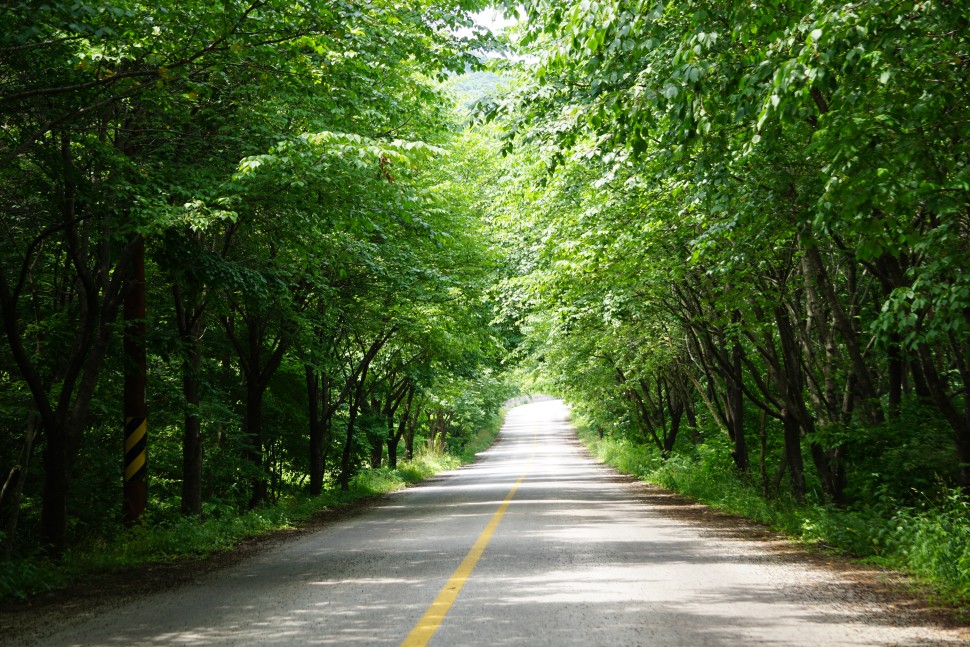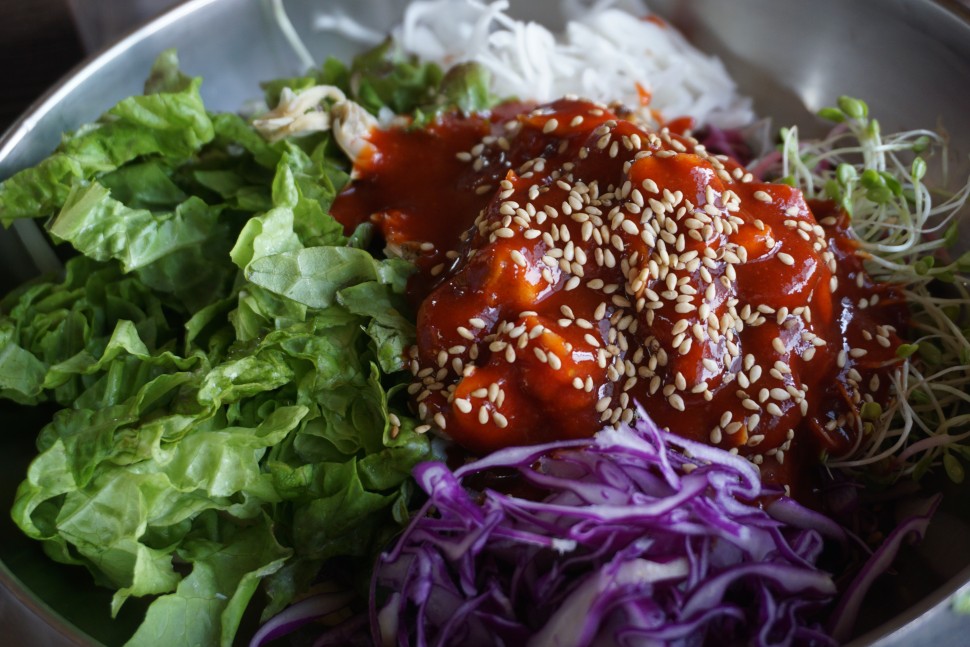[EXTRA] Buan: a county of hidden charms
Date Jul 03, 2023
 A forager works the mud flats near the island of Haseom on Buan's west coast, June 16, 2023. (Courtesy of Saul Latham)
A forager works the mud flats near the island of Haseom on Buan's west coast, June 16, 2023. (Courtesy of Saul Latham)
On the westernmost end of Buan’s Byeonsan Peninsula, Kim Jeong-hwa sits happily feasting on a fresh crab in his quaint, impeccably tidy seafood restaurant set on a tiny village street by the sea. He is a friendly man, toughened by 25 years of exposure to the region's wonderful natural elements and yet gentle and calm, softened and humbled by country living.
“There’s nothing special about Buan,” he says.
Buan is a county in Jeollabuk-do Province on the southwestern edge of the Korean Peninsula. Bordering the county’s vast plains are low-lying traditional hanok houses nestled among rice paddies, vegetable patches and bright manicured gardens with stone sculptures and yellow coreopsis flowers. A cool salty breeze blows off the Yellow Sea. This is a world in itself. A secret beauty, Buan is a flourishing, hidden land of adventure. It is a land of tradition and change – forward looking and reflective.
What is special about Buan is its people’s longstanding relationship with nature, and Kim represents so much about the place. He retains a country charm, an unassuming and generous character. He’s hard-working and content to accept his lot – and what a lot it is.
Yin and yang prove quite helpful in explaining Buan. The ocean and mountains join in harmony. Old and new coexist. The paddy fields reflect the sky. Neat parcels of land cultivate chili peppers, leek, spring onions, melons and more. In the summer, yellow onions dry in the sun and garlic is bundled on roofs and windowsills, a world away from Buan’s prolific winter snow.
“The people here are laid back,” said Kim sipping a glass of soju. “We are country people.”
 A country road runs up into the mountains of Byeonsanbando National Park, June 16, 2023. (Courtesy of Saul Latham)
A country road runs up into the mountains of Byeonsanbando National Park, June 16, 2023. (Courtesy of Saul Latham)
Across from the restaurant, on the pier, a fisherman imitates a mud crab dancing on the sea floor. Two older ladies, who are fishing as well, offer the last of their rice cakes and a sweet potato. Families cast lures out into the water. Just north, the busy fishing port of Gyeokpo sits beside a 200-meter cliff. Chaeseokgang Cliff displays some of the fantastic geological features that led to this area being designated a U.N. Global Geopark.
Byeonsan’s coastal road winds up and down alongside the water’s edge, sandy beaches and pines, showing views of beautiful islands like Haseom and the vast tidal flats of the Yellow Sea. It runs up through pristine mountain forests where the great Gaeamsa Temple and Jiksopokpo Falls hide behind colossal boulders in the folds of this quiet natural wonderland.
The cycle of life here is rich with a history made of, with and by the land and sea. The Buan Celadon Museum illustrates this. Kaolin clay has long been plentiful along the region’s eons-old tidal flats. Visitors to the museum can discover centuries-old ceramics crafts and learn about celadon through hands-on experience.
The region hosts many fascinating museums. At Buan Silkworm Town, visitors can learn about silkworms and their ecological connection to Buan’s mulberry trees. The Cheonglim Astronomical Observatory gives its visitors opportunities to gaze at the stars and learn about some of the oldest astronomy practices in the world. Seokjeong Literary Museum shows the works of local hero and national poet Shin Seok-jeong, while Maechang Park holds the tomb of hometown poet and artist Yi Mae-chang, who is still famous around half a millennium after his passing.
 Local favorite bajirak bibimbap (mixed rice with clams) is served at a restaurant overlooking the Yellow Sea, June 16, 2023. (Courtesy of Saul Latham)
Local favorite bajirak bibimbap (mixed rice with clams) is served at a restaurant overlooking the Yellow Sea, June 16, 2023. (Courtesy of Saul Latham)
Buan’s market town is a quiet, clean old place awaiting the curious and adventurous. Even its leaning power poles exude a certain country charm as if hanging on to an older, less urbane Korea. The locals’ hardworking and laidback spirit is evident here. They are imbibed with an unassuming humility.
Kim Jeong-suk, a vendor at Gyeokpohang, Buan’s central fish market, came to Buan about 40 years ago after getting married. “Buan is famous for its clams and clam soup,” she says as she sits cleaning clams in a bucket.
 Haseom sits on the horizon surrounded by high tide waters on Buan's west coast, June 16, 2023. (Courtesy of Saul Latham)
Haseom sits on the horizon surrounded by high tide waters on Buan's west coast, June 16, 2023. (Courtesy of Saul Latham)
Indeed the cuisine of Buan may be another secret to its flourishing people. Living on a part of the broader Honam plains – the food basket of Korea – the people of Buan are spoiled with choices and are healthier for it. Bajirak juk (clam porridge) is a favorite of visitors. Clams, ginseng, spring onion and mung bean are part of a thick rice broth with a smoky flavor.
 A fishing boat returns to quiet Gunghang port on the coast of Buan, June 17, 2023. (Courtesy of Saul Latham)
A fishing boat returns to quiet Gunghang port on the coast of Buan, June 17, 2023. (Courtesy of Saul Latham)
With such wonderful food and natural surroundings, it is surprising to hear Kim Jeong-suk echo the sentiment of Kim Jeong-hwa: “There’s nothing special about Buan. But it is close to the seaside!” she says.
The region anticipates some 43,000 young scouts from around 170 countries will visit to attend the 25th World Scout Jamboree in Saemangeum. Still, Buan’s people will continue as they always have, living well. The sea breeze will run through the mountain forests and the tides will rise and fall like divine lungs. Buan’s hidden charm will remain, written in the land and its people.
 Rows of yellow onions await sale during harvest season in Buan, June 16, 2023. (Courtesy of Saul Latham)
Rows of yellow onions await sale during harvest season in Buan, June 16, 2023. (Courtesy of Saul Latham)

The Ministry of Culture, Sports and Tourism's "Korea Here & Now" work can be used under the condition of "Public Nuri Type 1 (Source Indication)."




